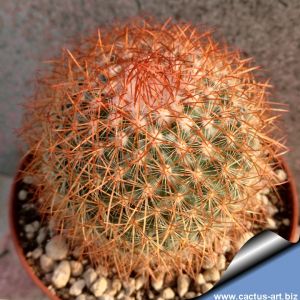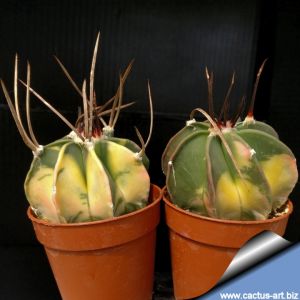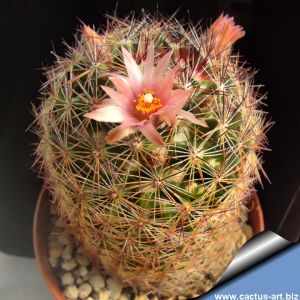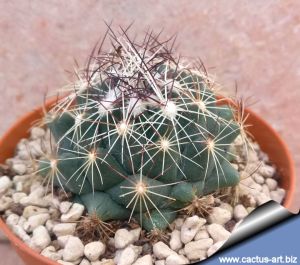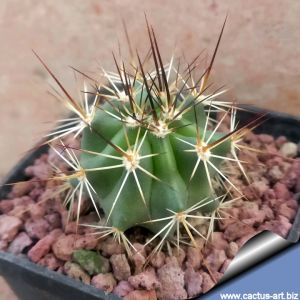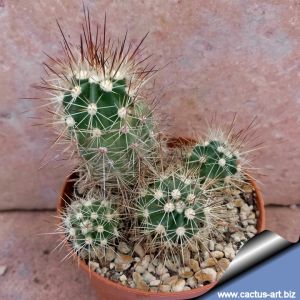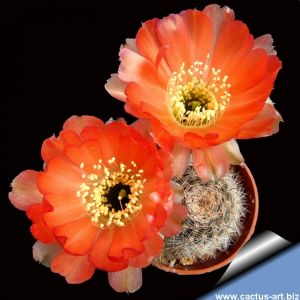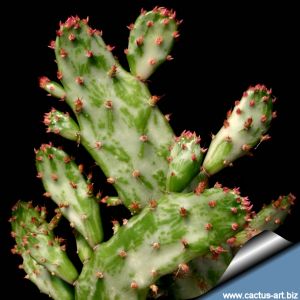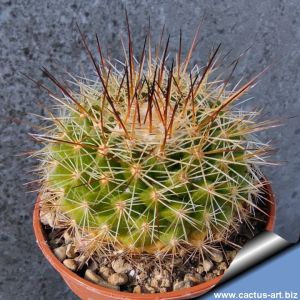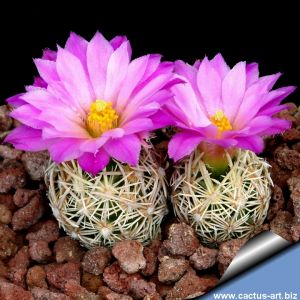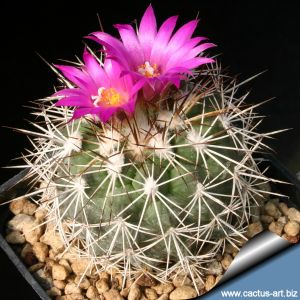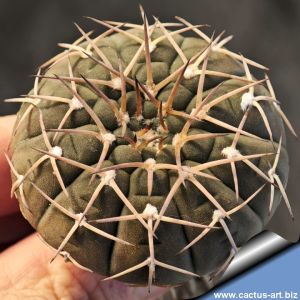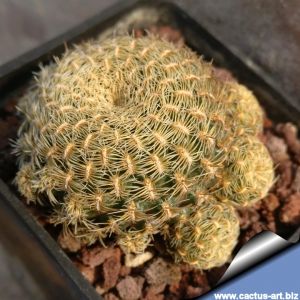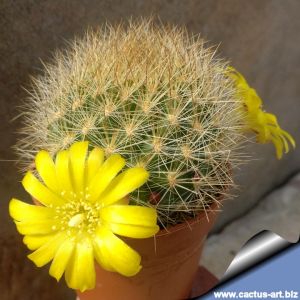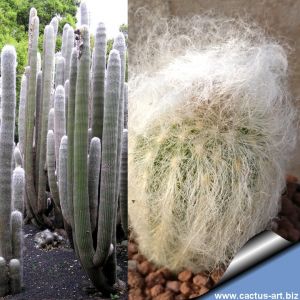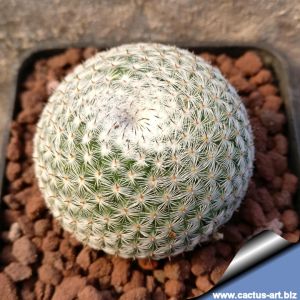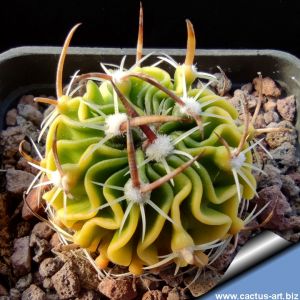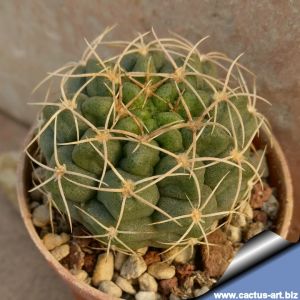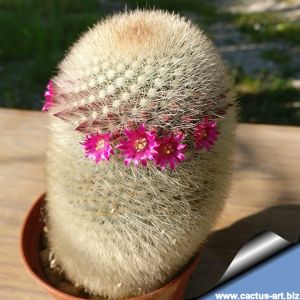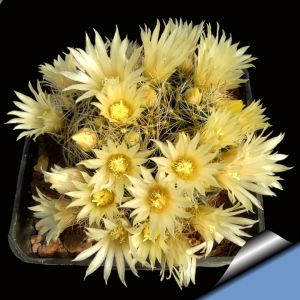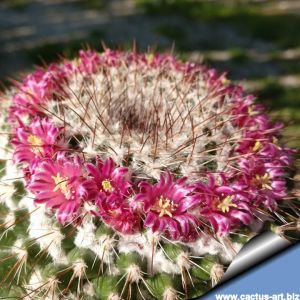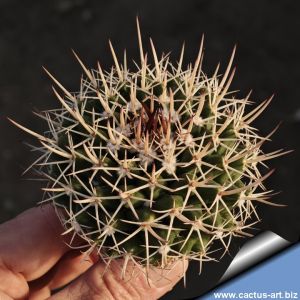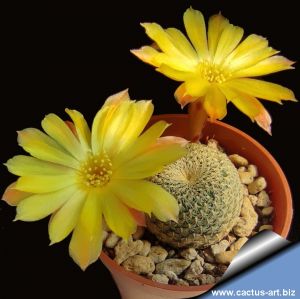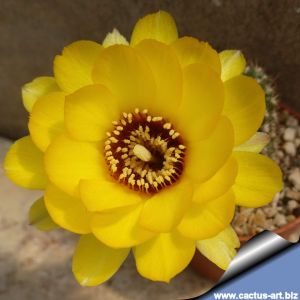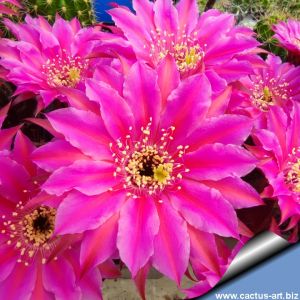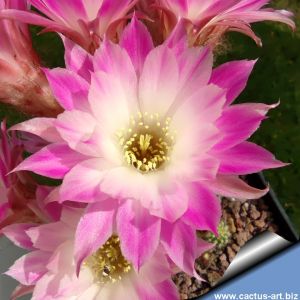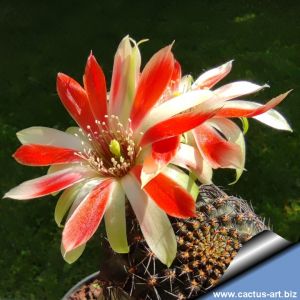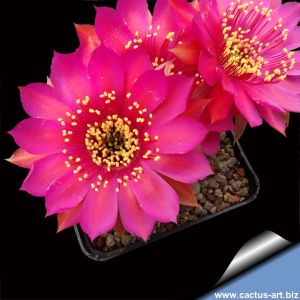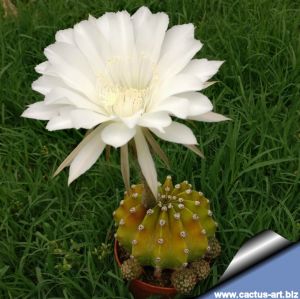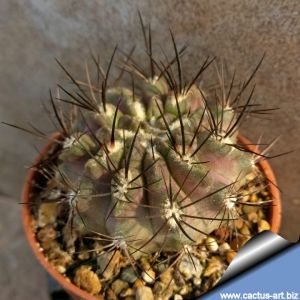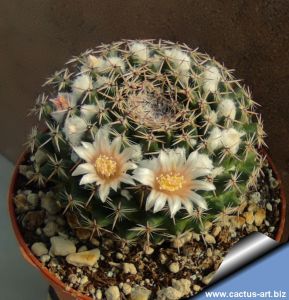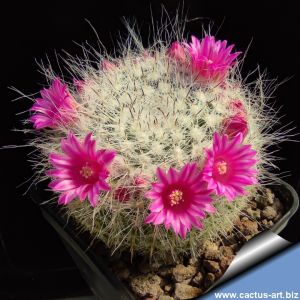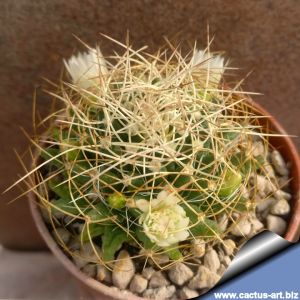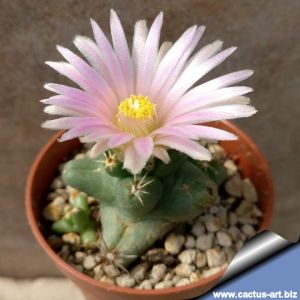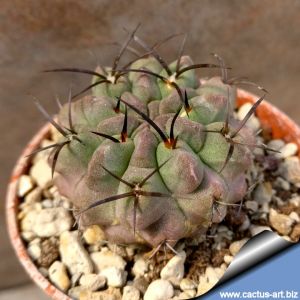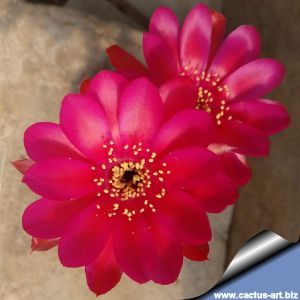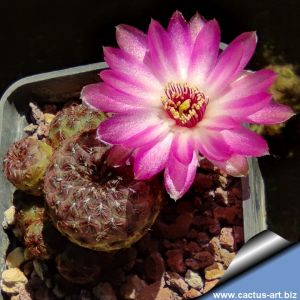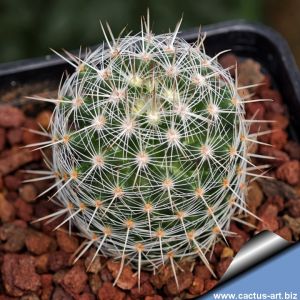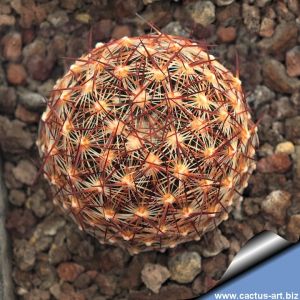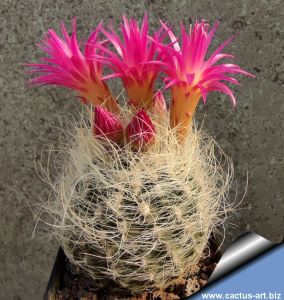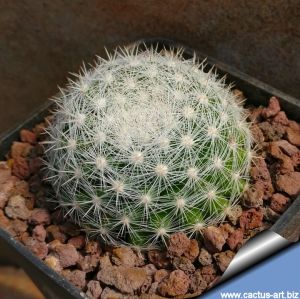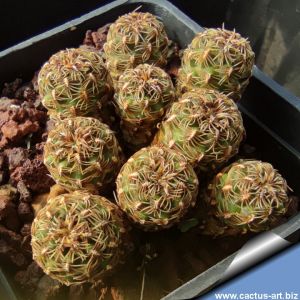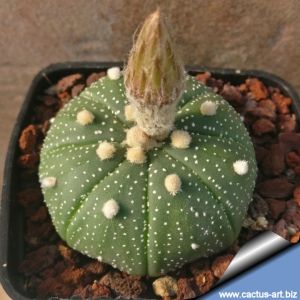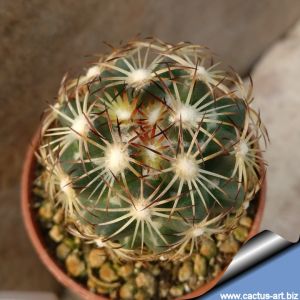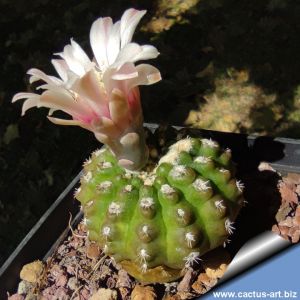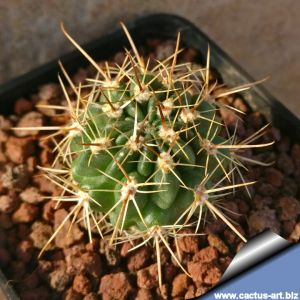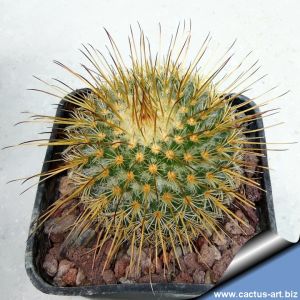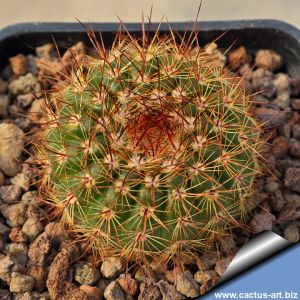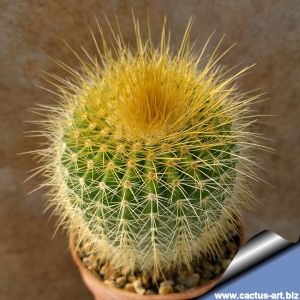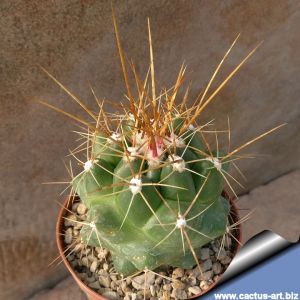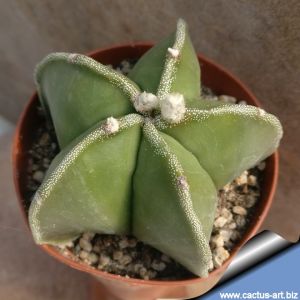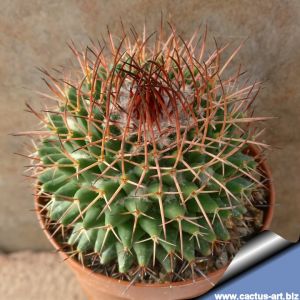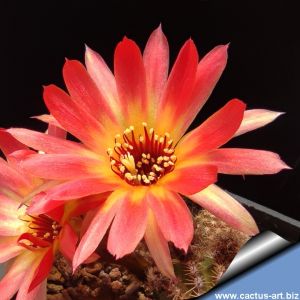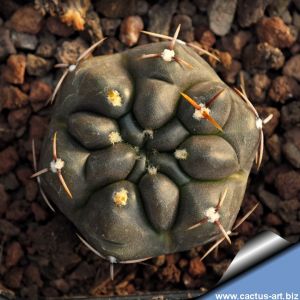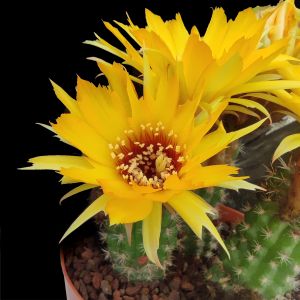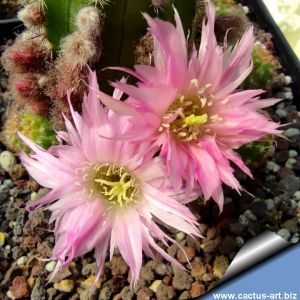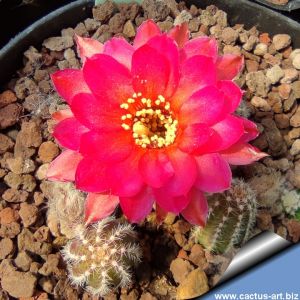-
1
The variety ruberrima is a particularly distinctive form of the species Mammillaria rhodantha . The term "ruberrima" comes from Latin and means "very red" or "ruby-colored," which perfectly describes this variety's defining trait.
-
2
Variegated plants have sectors, patches or stripes with two or more colours. Plants with variegated body are highly prized. Each specimen different and particular.
-
3
A very spiny cactus with single or occasionally clustering stems. Short tubercles are densely covered with white or light-brown radial spines and stronger central ones that often hide the stem. Small pale-pink to soft-violet flowers bloom at the apex.
-
4
-
5
Pretty form with darker spines, deep pink-magenta flowers.
-
6
Magnificent orange flowers!
-
7
-
8
-
9
Also known as “Joseph's Coat” is one of the very few naturally occurring white-variegated cacti. As its name suggests, this cactus is variegated or marbled with white, creamy-white, yellow, green and sometimes also with pink in varying patterns.
-
10
-
11
Mammillaria rhodantha is a shortly columnar cactus that characteristically divide dichotomously with age forming large clumps. The spines are the more variable of the trait. The dark form has vivid dark reddish-brown central spines.
-
12
-
13
Escobaria minima is a rare, tiny cactus notable for its miniature size—it can flower at just 1 cm in diameter. Stems are solitary or clumping, with dense ivory to yellowish spines and pink to magenta flowers. It thrives in limestone-rich soils.
-
14
A small, slow-growing cactus with a blue-green to olive stem arising from a thickened, fascicled root. Radial spines are straight, rigid, interwoven, brown turning grey-white with dark tips. Flowers are deep purple with a pale throat.
-
15
Gymnocalycium stellatum is a beautiful slowly growing cactus. The stem is noticeably flatten dark greyish-brown to olive coloured. Spines 3, yellow to brown, becoming grey with age, add-pressed straight to slightly curved and flattened against the stem.
-
16
-
17
-
18
Low, clustering stems with pectinate spines pressed flat against the surface, ranging from off-white to greyish or light brown. Notable for its outstanding glossy purple flowers.
-
19
-
20
A columnar cactus covered in a dense, woolly white fuzz. Native to the arid, mountainous regions of Peru and Ecuador above 1000 m, where this woolly coat acts as a shield against intense solar radiation and cold nighttime temperatures.
-
21
Globose stems with a depressed apex, so densely covered in short spines and woolly axils that the surface is nearly invisible. Small flowers form a crown around the top, in shades from carmine to purplish-pink.
-
22
Variegated plants with yellow-tinged epidermis. Grown from seeds of variegated parents.
-
23
-
24
-
25
-
26
Stem, tuberous at the base, globose to ovoid in shape. Spines are fine, bristle-like and pubescent—yellowish below, white mid-length, brown or amber at the tips. A genuine winter bloomer, producing greenish-white flowers even when very young.
-
27
Symmetric round cactus with short, hard spines. Small purple flowers form a ring around the stem apex.
-
28
‘Horrida’ is a striking form distinguished by formidable, more robust spines than the typical species. Its low habit and rapid growth make it highly ornamental , and over time it develops into a majestic hemispheric cushion. Flowers are pink-purple.
-
29
-
30
-
31
Large star-shaped flowers in vivid magenta, fading to lighter edges with a darker central vein. Numerous pale-yellow stamens and a light-green pistil create striking contrast and a remarkable visual impact.
-
32
Striking blooms feature a white center softly transitioning to pink-magenta at the edges and outer petals. The light throat accentuates creamy stamens, offering an elegant contrast to the rosy gradients. Profuse, radiant, and subtly bicolored flowering.
-
33
Selected clone with 2-colored flower, inner petals red with whitish tips, outer petals greenish and reddish white. Body small, dark purple-green almost black. BEAUTIFUL!!!
-
34
-
35
A clustering plant forming dense groups around the main body. The stem is globose, dark green, with well-defined ribs and short dark spines. White trumpet-shaped flowers exceed 20 cm and appear repeatedly from spring through summer.
-
36
Eriosyce taltalensis is spiny geophytic cactus with stems rising barely above ground level. The stem is globose or semi-globular dull dark green, in the sun often tinged with purple. The roots are fibrous, arising from a short, conical taproot.
-
37
-
38
Mammillaria woodsii, white stem with small tubercles, each adorned with white radial spines and brown-black centrals, set in thick wool. Flowers form a reddish-purple crown in spring and summer. Beautiful!
-
39
Dwarf form of ARIZONA SNOWCAP
-
40
A newly introduced trailing cactus similar to Chamaecereus silvestrii, yet featuring markedly thinner and longer stems. Ideal for hanging baskets. Showy orange blooms. Available in limited numbers!
-
41
Mammillaria camptotricha (Dolichothele camptotricha) - Flat clusters of small stems with elongated tubercles and slender, twisted spines that envelop the body (hence "Bird’s Nest Cactus").
-
42
-
43
Solitary stem boasting a stunning grey-blue-green hue with purple hints, topped with white wool. Its flowers are subtly hued in green, cream, or pink.
-
44
-
45
Stem with a metallic sheen between aquamarine green and bronze, bearing fishbone-shaped spines in rust or light brown tones. Freely offsets to form small, flattened cushions. Beautiful and rare.
-
46
Long cylindrical body with many white spines on large tubercles arranged in regular spirals. Spines are firm and completely straight. Bears light pinkish pastel-colored flowers from the top.
-
47
Exceptionally tough, featuring large woolly beige areoles, creamy radial spines, and striking brick-red centrals. Lovely! Fully winter hardy (winterhart).
-
48
Selection of Eriosyce gerocephala with thin, soft, and flexible spines in pure white to creamy-white. The
dense, bright white spination gives the plant a luminous appearance and significant ornamental value.
-
49
Mammilloydia candida called 'Snowball' is a choice cactus with a so dense snowy white, spination, that its body appears hidden by spines. Mammilloydia are clearly related to the genus Mammillaria, but it is usually recognized as a segregate genera.
-
50
This flower dazzles with vivid hues: rich violet margins, a bold carmine-red central band blending into warm salmon-orange at the center. The white throat and purple stamens add elegant contrast.
-
51
Showy pink-violet blooms paired with remarkable spines—central ones begin short but elongate and flatten dramatically as the plant ages, creating a unique silhouette.
-
52
-
53
Short, combed spines from yellow-beige to light brown, with darker bases. Fast-growing and quick to cluster, it forms tight cushions packed with numerous heads.
-
54
Astrophytum asterias is small, round, spineless and squat cactus. The disc-shaped body is divided into 8 ribs, greenish-brown and may appear speckled from its covering of white scales. The flowers of this cactus are yellow with red red bases.
-
55
Turbinicarpus schmiedickeanus ssp. dickisoniae is similar to Turbinicarpus schmiedickeanus ssp. gracilis the closest variety. Radials spines 18-24 white 2mm long on young areoles (areole in old specimens have only central spines).
-
56
Variety with a round, dark green body and stiff, pectinate spines. It produces large yellow flowers with red anthers. A truly captivating plant.
-
57
Compact and distinctive cultivar with ribs divided into small tubercles and very short spines that define its uniqueness. This specific structure creates a characteristic look that stands out clearly.
-
58
Lobivia jajoiana is a very popular small cactus priced for the throat ring of the flower that is always of a very dark purple-violet to black. The var. fleischeriana has orang or red flowers.
-
59
Very pretty plants with long pale amber to reddish central spines, pink flowers.
-
60
Spherical stem with umbilicate depression at apex, armored by interlocking copper-brown spines.
-
61
Opuntia sulphurea has conspicuously tuberculate joints. The spines are very dense and stiff, horncolored. Flowers about 4 cm. long, yellow.
-
62
Copiapoa maritima comes from a habitat with an extremely arid climate, they are remarkably tolerant of pot culture. These plants have thick taproots and are susceptible to overwatering.
-
63
Spectacular bicolored flower: brick-red petals with a central orange midline, outer petals gradually brightening to vivid orange-yellow. A dark throat and dense cream stamens complete a vibrant, radiant, and visually striking bloom.
-
64
Notocactus claviceps is a smaller growing form of Notocactus schumannianus that does not exceed 50 cm in height. It has attractive light yellow (nearly white) flowers in summer.
-
65
Globular cactus with prominent tubercles and showy yellow blooms. Its straight vertical central spines (2-7 cm long) range from golden to reddish-brown when young, fading to grey. The vibrant flowers offset the spination beautifully.
-
66
Astrophytum myriostigma var. subnudum (partially naked form) is similar to A. myriostigma nudum, but deviates from it for having only a few white spots. The spots often form nice patterned designes on the dark green body.
-
67
Mammillaria carnea is a rather robust cactus species. The plant typically has 4-sided angular tubercles with yellow, woolly axils and only 4 reddish radial spines. It will reward the skilled growers with ring of fine flesh-pink flowers circling the crown.
-
68
Chamaelobivia ‘Golden Eye’ is a striking hybrid featuring vibrant orange-red blooms and a prominent golden-yellow center—the “Golden Eye” that inspired its name.
-
69
Gymnocalycium gibbosum var. chubutense distingushes for the unusual dark green to nearly black stem and for the cream-white or pinkish flowers. In its habit during winter there are heavy snows and frosts can occur throughout the year.
-
70
Flowers happen different to each other. Some have thin sharp petals while others are most normal. Odd features!
-
71
Pale pink flower. The shape of the petals varies a lot during the various blooms. Sometimes they are thin and very jagged while other times they can have smooth edges without indentations, or they can be intermediate in shape (even on the same plant).
-
72

